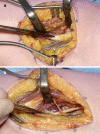Anterior interosseous nerve syndrome: retrospective analysis of 14 patients
- PMID: 21611763
- PMCID: PMC3195807
- DOI: 10.1007/s00402-011-1322-5
Anterior interosseous nerve syndrome: retrospective analysis of 14 patients
Abstract
Introduction: The anterior interosseous nerve (AIN) is a only motor nerve innervating the deep muscles of the forearm. Its compression is rare. We present a retrospective analysis of 14 patients with an AIN syndrome with a variety of clinical manifestations who underwent operative and conservative treatment.
Patients and methods: Fourteen patients (six female, eight male, mean age 48 ± 9 years) were included. In six patients, the right limb was affected, and in eight patients the left limb. Conservative treatment was started for every patient. If no signs of recovery appeared within 3 months, operative exploration was performed. Final assessment was performed between 2 and 9 years after the onset of paralysis (mean duration of follow-up 46 ± 11 months). Patients were examined clinically for return of power, range of motion, pinch and grip strengths. Also the disability of the arm, shoulder, and hand (DASH) score was calculated.
Results: Seven of our 14 patients had incomplete AIN palsy with isolated total loss of function of flexor pollicis longus (FPL), five of FPL and flexor digitorum profundus (FDP)1 simultaneously, and two of FDP1. Weakness of FDP2 could be seen in four patients. Pronator teres was paralysed in two patients. Pain in the forearm was present in nine patients. Four patients had predisposing factors. Eight patients treated conservatively exhibited spontaneous recovery from their paralysis during 3-12 months after the onset. In six patients, the AIN was explored 12 weeks after the initial symptoms and released from compressing structures. Thirteen patients showed good limb function. In one patient with poor result a tendon transfer was necessary. The DASH score of patients treated conservatively and operatively presented no significant difference.
Conclusion: AIN syndrome can have different clinical manifestations. If no signs of spontaneous recovery appear within 12 weeks, operative treatment should be performed.
Figures
References
-
- Arenas AJ, Artazcoz FJ, Tejero A, Arias C. Anterior interosseous nerve injury associated with a monteggia fracture-dislocation. Acta Orthop Belg. 2001;67:77–80. - PubMed
-
- Casey PJ, Moed BR. Fractures of the forearm complicated by palsy of the anterior interosseus nerve caused by a constrictive dressing. J Bone Joint Surg Am. 1997;79:122–124. - PubMed
-
- Chidgey LK, Szabo RM. Anterior interosseus nerve palsy. In: Szabo RM, editor. Nerve compression syndromes. Thorofare NJ: Slack Inc; 1989. pp. 153–162.
MeSH terms
LinkOut - more resources
Full Text Sources


